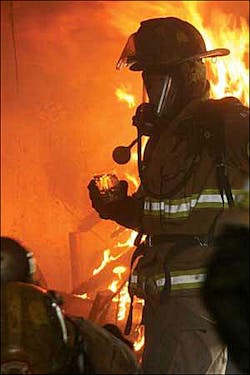Photo Spurs Investigation into Florida Department's Training Burns
Click Here to View Firehouse Forum Discussion
HIGH SPRINGS -- Concerns over the safety of a recent controlled burn conducted by the High Springs Fire Department has launched a Florida State Fire Marshal's Office investigation into the matter.
The controlled burn and smoke training, performed in the morning and afternoon of Jan. 21, was meant as a way to train firefighters, both rookies and veterans, in varying aspects of firefighting and fire rescue.
But an article and pictures that explained the exercises in the Jan. 25 edition of The High Springs Herald came under scrutiny by an online message board for firefighters, many of whom said the fire department did not follow safety guidelines.
The matter then was brought to the attention of the State Fire Marshal's Office, which then launched an investigation.
When previously interviewed, High Springs Fire Chief Terry Jewell, Firefighter and Emergency Medical Technician Dwayne King and Lt. Bruce Gillingham all said that safety was one of the main concerns when preparing for and conducting a controlled burn.
The National Fire Protection Association sets standards that firefighters across the county follow when conducting live fire training.
But Dave Casey, bureau chief of Fire Standards and Training with the State Fire Marshal's Office, said that some of those standards may not have been followed.
The greatest concern he had, he said, was the use of a flammable liquid to light the fire. A picture that accompanied the Herald article showed a firefighter holding a glass of flammable liquid in a burning room.
"That's very clearly not allowed," Casey said. "It (the book of guidelines) apparently was not followed in this case."
Jewell said that the liquid inside the glass was diesel fuel. And the flammable liquid was only used in parts of the burn, he said, and not during training drills in which inexperienced firefighters were inside the structure.
The firefighters have nothing to hide regarding their training practices, Jewell said, and that is the reason Herald photographers were allowed at the burn in the first place.
Casey said that his department's job is to make sure that no one is hurt, that firefighters have proper training and that all are well informed of safety guidelines.
And while his main objective is not to punish fire departments for safety violations, Casey said, investigations that find violations could result in repercussions for the department.
For example, the accidental death of a firefighter who was engaged in physical training exercises in Jacksonville in 2005 resulted in a Fire Marshal investigation.
As a result, the Fire Marshal issued a summary of findings to reduce risks of similar incidents along with a remediation plan directing the Jacksonville Fire Rescue Department and other departments statewide to comply with new rules.
Additionally, a recent change to live fire requirements states that a live fire training instructor certification shall be revoked if full compliance with the NFPA guidelines is not met.
Casey said that High Springs firefighters already had been interviewed by the Fire Marshal's office for the investigation.
But the results of the investigation are not yet public record, he said.
"It's a current investigation," he said. "We're very limited in what we can talk about."
On the firefighter's forum in which the article and photos were scrutinized, one of the issues that people discussed was the use of "live victims" during training.
That forum is found at Firehouse.com The NFPA guidelines on live fire training state that, "No person(s) shall play the role of a victim inside the building."
But Jewell said, both in the previous story and after the investigation began, that the live victim portion of the training was not when the structure was on fire, but when the firefighters were doing smoke training.
"We did not have live victims during the fire; we never have and we never will," he said. "That was during smoke training. It gets my firemen comfortable that they can get their brothers out when they need to."
And those who portray victims are wearing air tanks the entire time, he added.
"Everybody involved had a positive experience, and nobody was hurt," he said. "There was nobody ever in danger."
People who posted on the firefighters' forum also took issue with the "rookie roast," in which inexperienced firefighters are paired with a more experienced firefighter and asked to endure the heat of a burning structure for as long as they safely can.
"It gives the individual an idea of the conditions that can occur when you go in to fight a fire," Jewell said.
Also, he added, some people were upset with the term "rookie roast," but that is slang that has been around at least since 19 years ago when Jewell was in fire college.
The term gives the experience a bad name, he said, but the training is vital for firefighters who need to know how much heat they can take so they can be safe when they have to respond to a call of a fire that is not under their control.
The "rookie roast" portion of the training is not even performed in a burning room, Jewell added, but in a different portion of the home than the area that is lit.
That way, the firefighters get the full experience of the smoke and the heat without as much danger.
"There's no intention of hurting anybody," Jewell said. "We just make them a little uncomfortable." Jewell said he is confident that the investigation will find that the fire department did nothing wrong.
"We do live fire training the way it's done all over the world," he said. "I know I have not done anything wrong."
Courtesy the High Springs Herald
Related Articles
